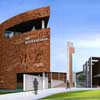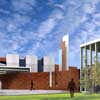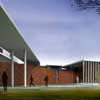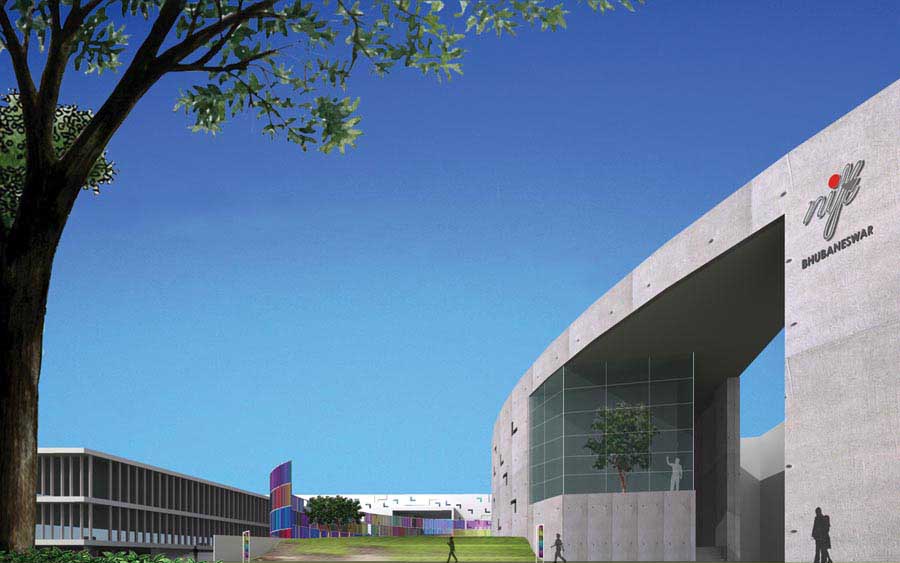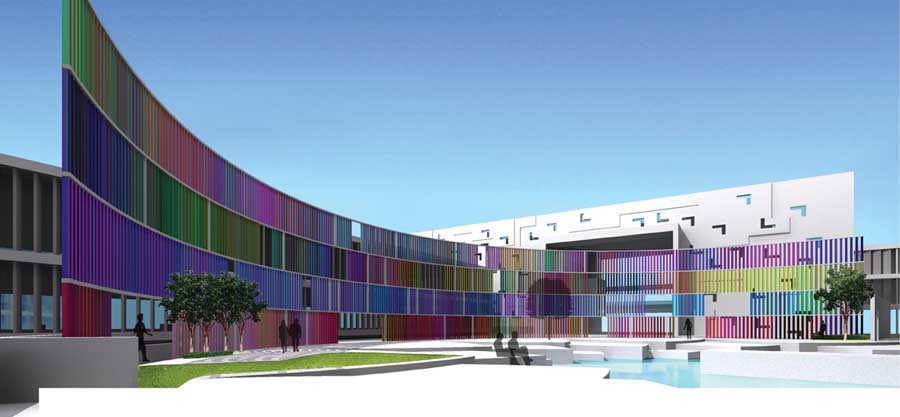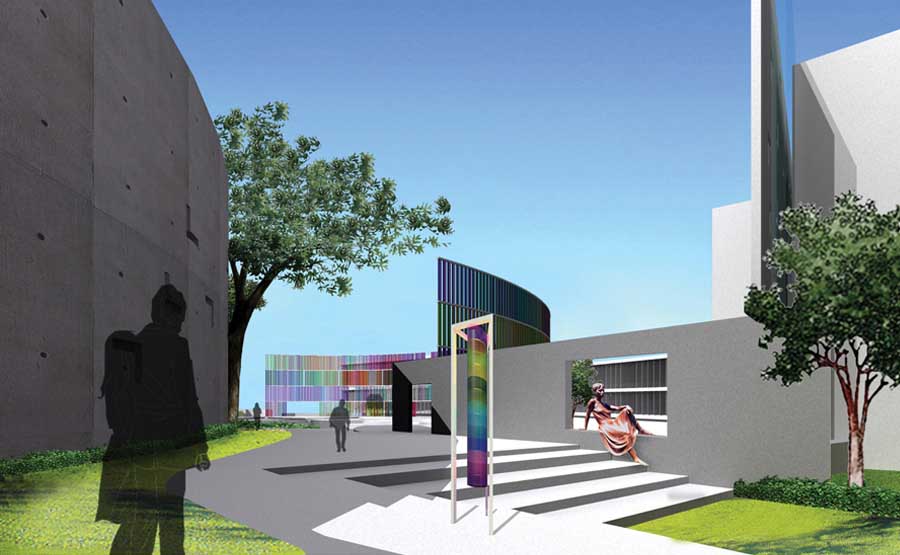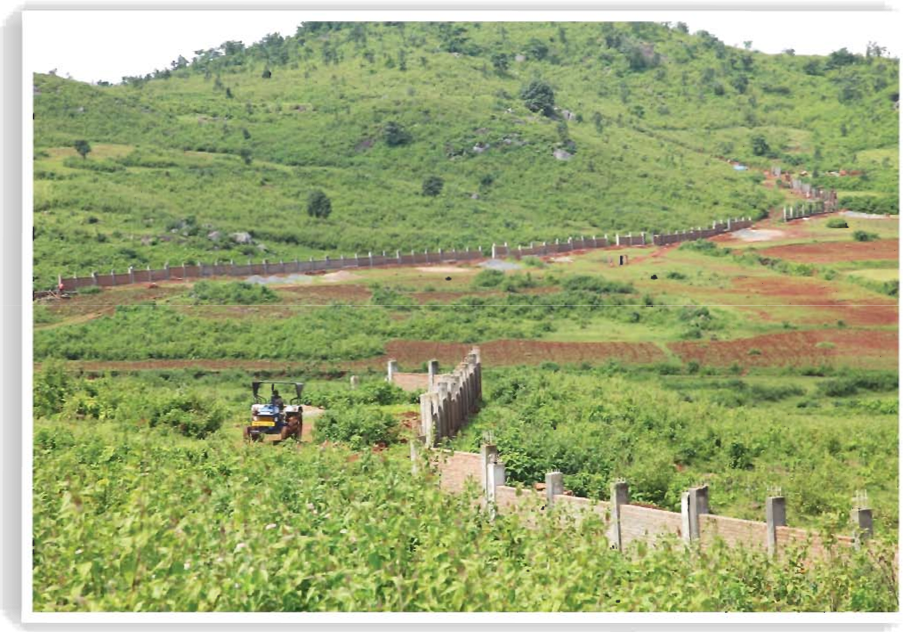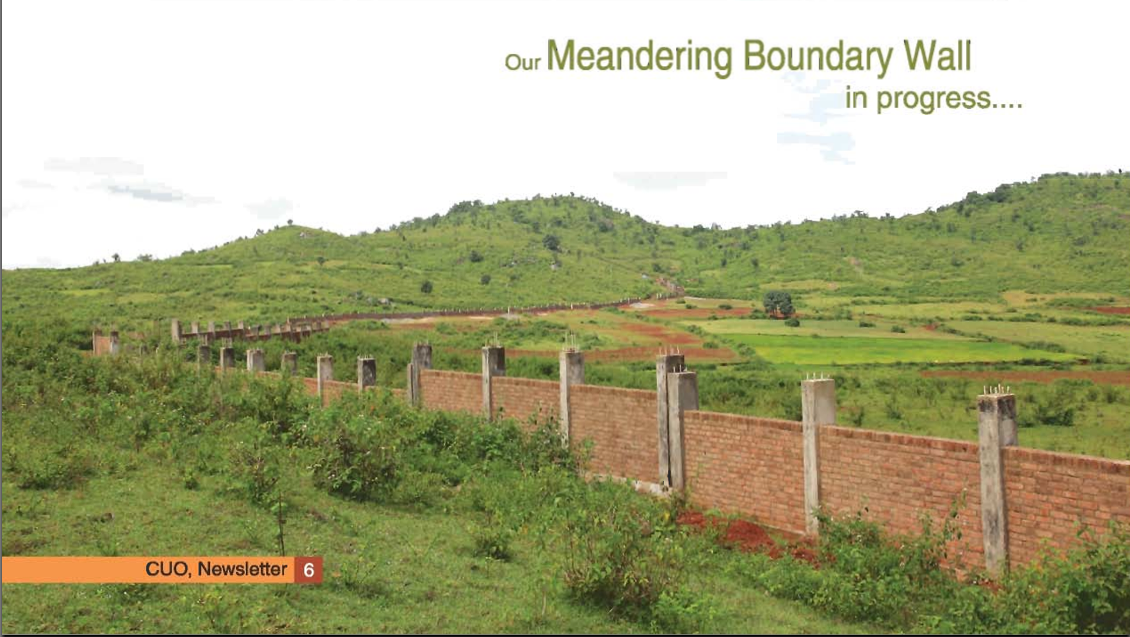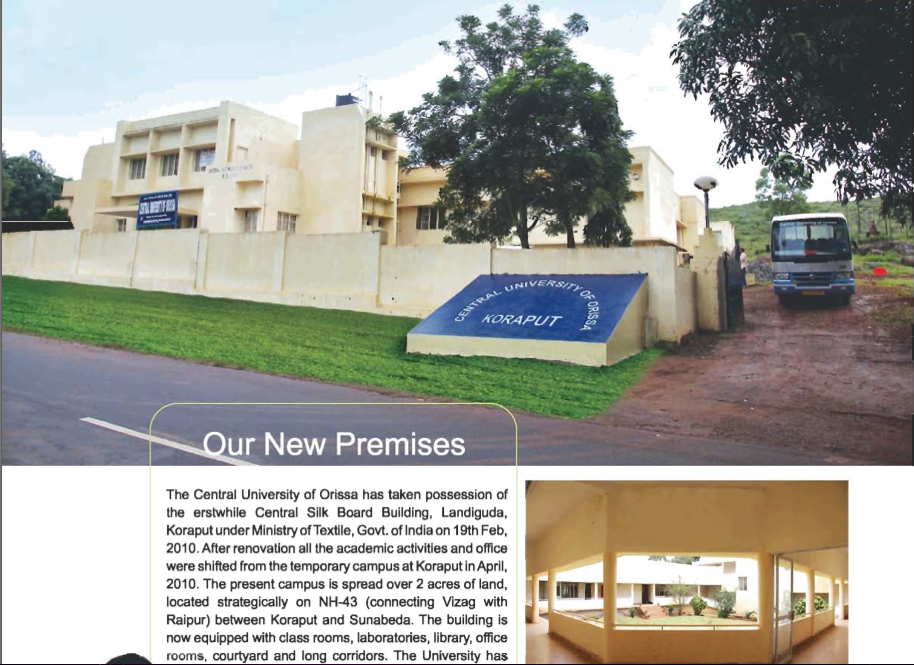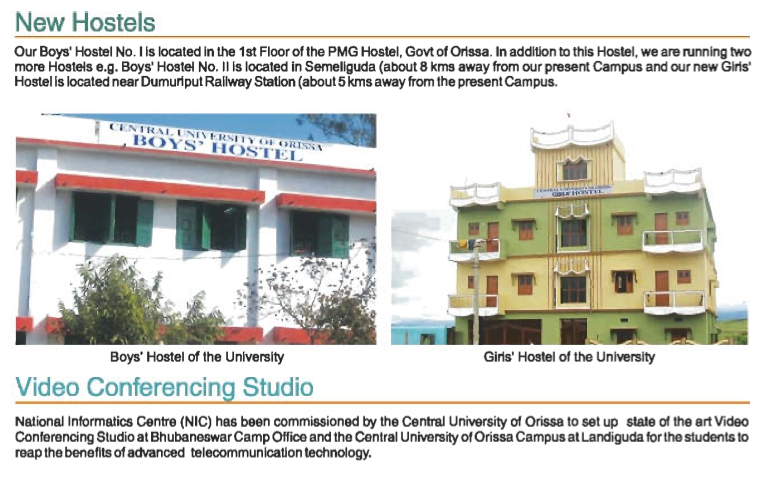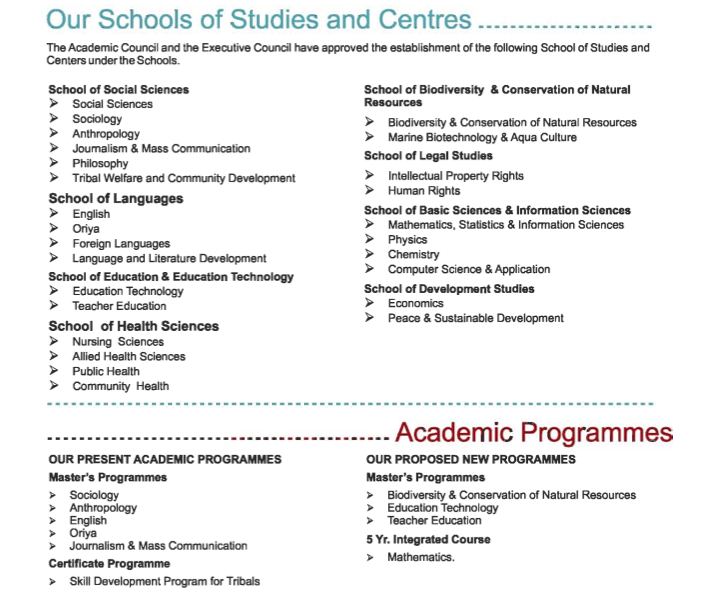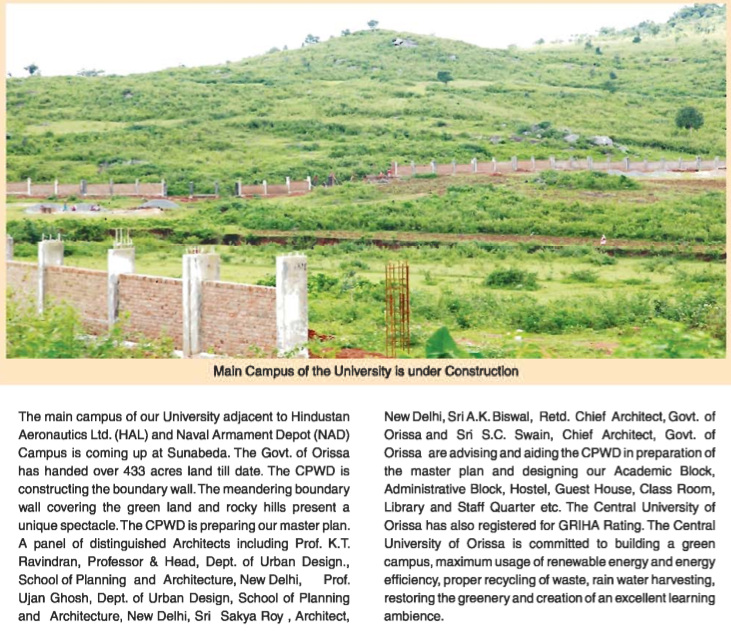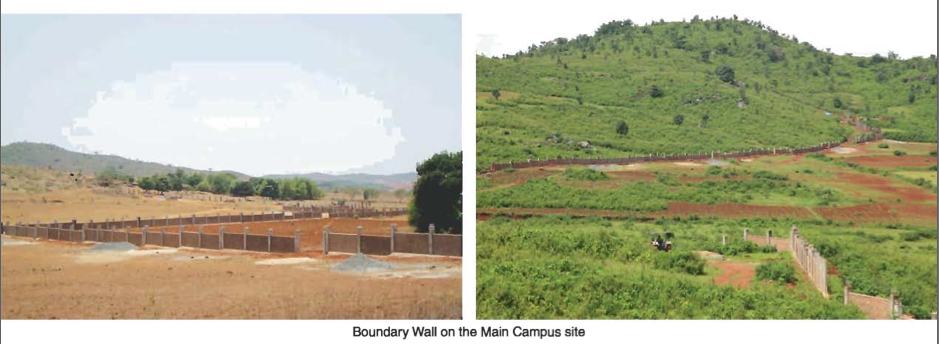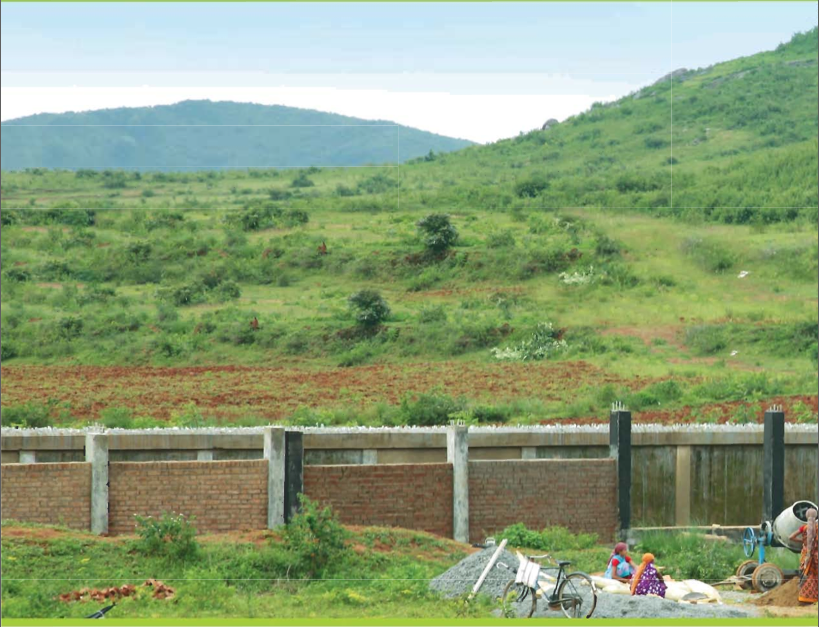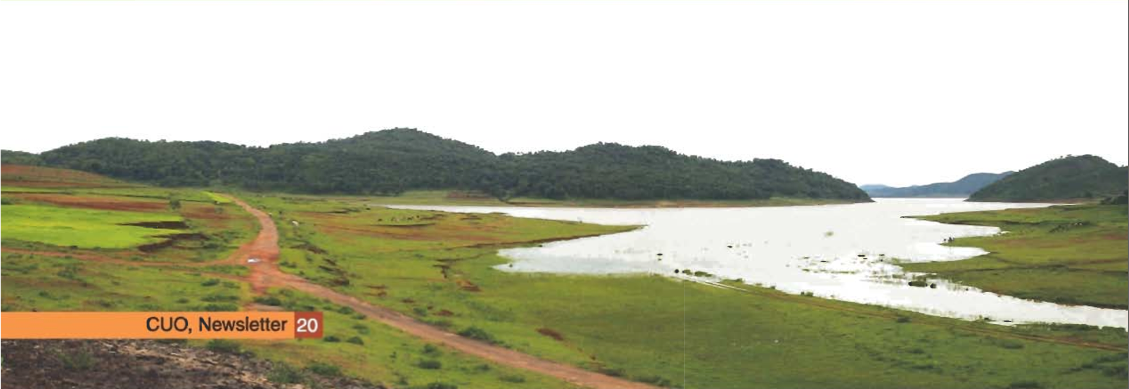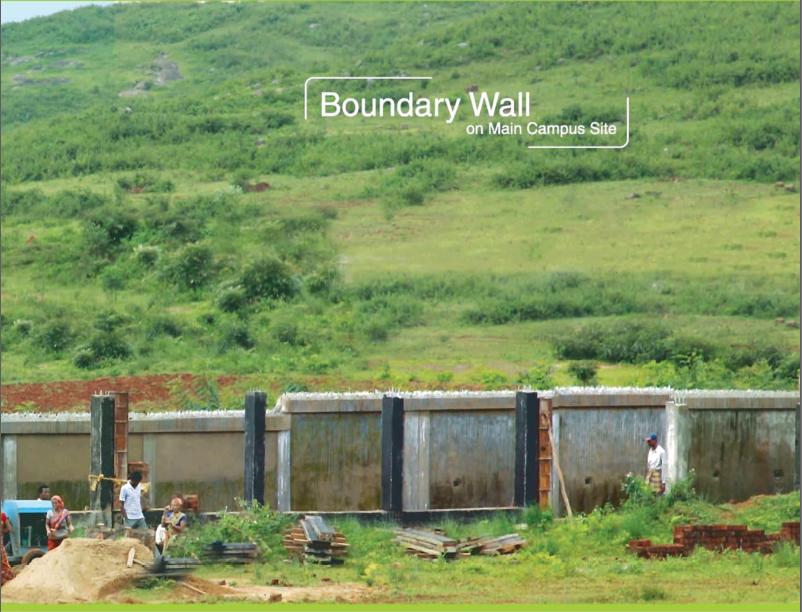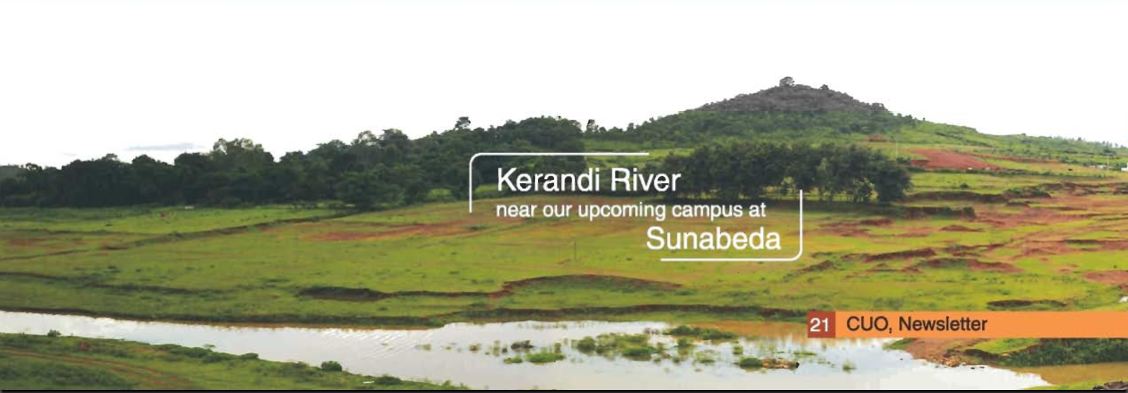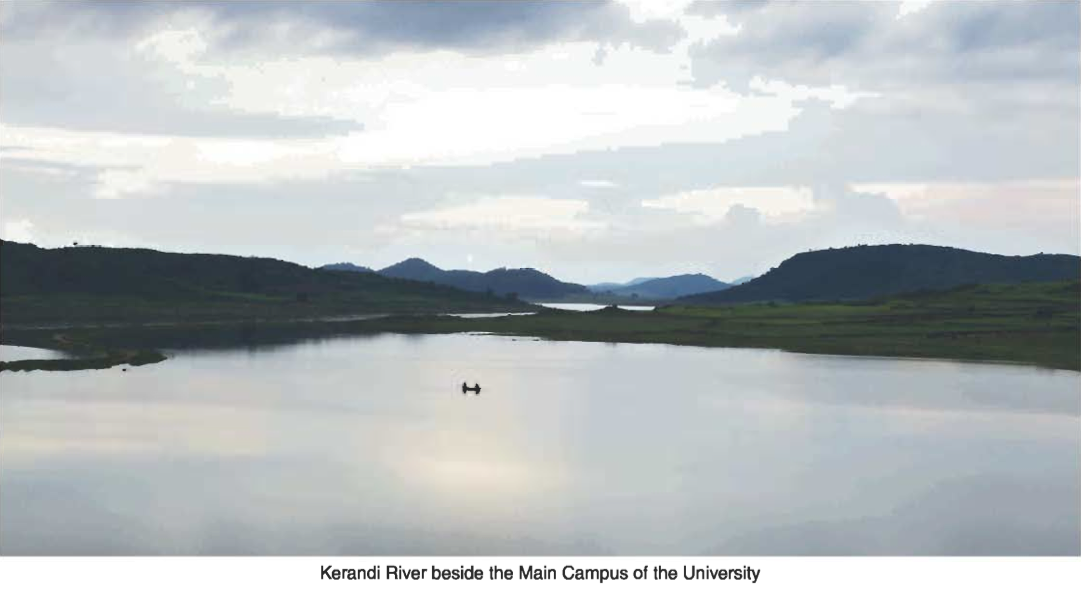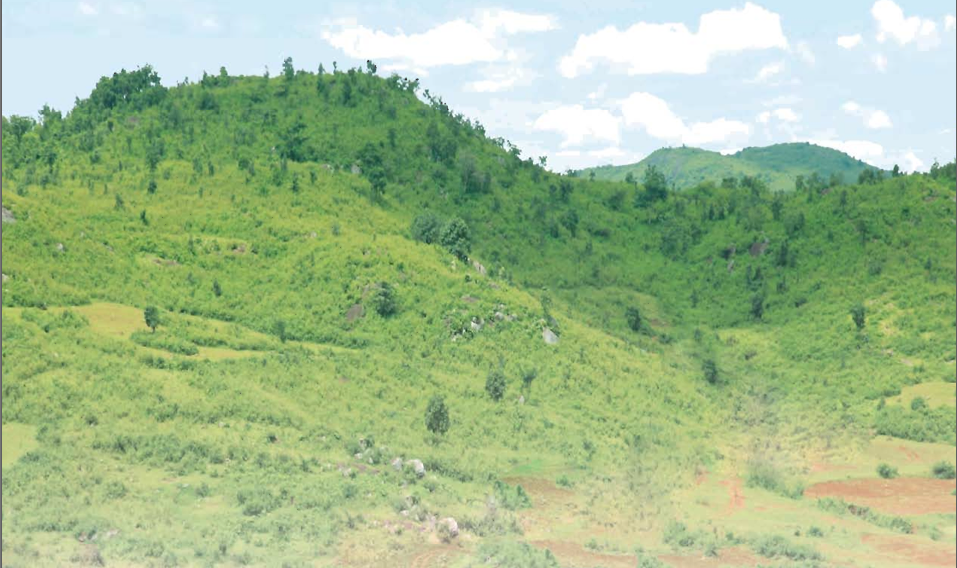Archive for March, 2011
To get a clear picture on higher education moves by the state government (during the last 5 years) outside of the capital area (Khurda, Cuttack and Puri districts) we try to list the moves. Many fully centrally funded institutes are mentioned as the state contributes by free land and in making the location decision. (Note that Odisha has 30 districts.)
What has been done so far (including under construction):
- Central University of Orissa, Dist – Koraput
- Upgradation of UCE Burla to VSSUT, Dist – Sambalpur
- Private University status to Centurion, Dist – Gajapati
- Government Engieering College, Bhawanipatna, Dist – Kalahandi
- College of Agriculture, Bhawanipatna, Dist – Kalahandi
- WODC funds and free land for Private Medical College, Jaring, near Bhawanipatna, Dist – Kalahandi (significant part of the construction is complete)
- Pushed Vedanta to establish Vedanta Science College in Lanjigarh, Dist – Kalahandi
- Parla Maharaj Engineering College, Berhampur, Dist-Ganjam
- Special SUIIT institute as part of Sambalpur University, Dist – Sambalpur
- WODC funds for Hi-Tech Medical College, Rourkela, Dist – Sundergarh (under construction)
- Indian Institute of Handloom Technology, Baragarh
- College of Horticulture, Chipilima, Dist – Sambalpur
The districts involved above and the number of items for them are: Baragarh (1), Gajapati (1), Ganjam (1), Kalahandi (4), Koraput (1), Sambalpur (3), Sundergarh (1). If one takes the funding amount as the criteria then Koraput comes at the top.
Some of the announcements that are most likely to happen in 1-3 years as reported in the news:
- Pushed MCL to agree to make a medical college in Talcher
- Pushed NTPC to agree to make a medical college (location not announced)
- Pushed NTPC to agree to make a Power Institute (location not announced)
- Announced that all three medical colleges (includes Berhampur, Sambalpur) will be autonomous starting with the one in Sambalpur.
- Announced that Khallikote College Berhampur will be made to a university
- Proposed that one of the 20 IIIT should be in Berhampur.
- Pushing to upgrade FCI Balangir to an Institute of Hotel Management
- Grants to XIMB to open a campus in Balangir
- Grants to XIMB to open a campus in Sambalpur
- Support for a CIPET campus in Balasore
- Upgradation of GM College, Sambalpur to a university (announed by Higher Education Minister)
The districts involved in the above two lists and their number of items are: Angul (1), Balasore (1), Balangir (2), Baragarh (1), Gajapati (1), Ganjam (4), Kalahandi (4), Koraput (1), Sambalpur (6), Sundergarh (1).
The districts that are left out are: Bhadrak, Bouda, Deogarh, Dhenkanal, Jagatsinghpur, Jajpur, Jharsuguda, Kandhamala, Kendrapada, Keonjhar, Malkangiri, Mayurbhanj, Nabarangpur, Nayagarh, Nuapada, Rayagada and Sonepur.
Besides the above there have been reports about government willing to give grants to several private medical colleges in various places and the WODC has tried (but failed) to entice (through grants and free land) a private party to establish a medical college in Balangir.
Also, I think the government will implement some of the recommendations made by the higher education task force.
Please suggest missing items in the comments section. Any capital-bashing comments will be deleted as the purpose of this post is to get a clear picture of what is happenning and not happening in the higher education side outside of the capital districts of Khurda, Cuttack and Puri.
Again, this list is to get a clear picture of what has happened in the non-capital area districts so that one can make an informed decision if the government is biased towards some non-capital districts over other non-capital districts. (There is no argument that the bulk of the moves have been made favoring the capital area. So no discussion on that.)
In regards to my personal view on what the government ought to do, it is listed in details in the site http://orissa2020.org.
The above list should not be interpreted in isolation. For example, one should not conclude that Kalahandi got too much. It got several institutions because it started from very little and the education conscious people of Kalahandi have been rightly demanding for higher education institutions for a long time. But at the same token, arguing that Kalahandi has been neglected by this government with respect to higher education just goes against the facts above and I worry that the well-meaning people who are making such arguments may be harming their cause. I guess the argument comes from losing the central university to Koraput. But then every district other than Koraput (and the capital districts) can use that argument. [If there is interest I will explain more on my take on this in the comments section.]
As an analogy, in 2005 we could rightly argue that the central government neglected Odisha with respect to centrally funded higher education institutions. But if we now say that the UPA government neglected Odisha with respect to centrally funded higher education institutions, we will be laughed at, and our efforts will have negative impact. So we plan to use finer arguments and location specific arguments to push for central institutions in Odisha for the 12th plan.
Kalahandi people wanting more institutions in Kalahandi should think of other ways to make their case and irritating the state government and its bureaucrats with arguments that go against the facts (see list above) may help some politicians but has a higher potential to harm Kalahandi’s case than help its case.
March 29th, 2011
Following is from an article in Times of India.
Twelve years down the line since its establishment, the foundation structure of Balangir Medical College looks like an abandoned cemetery overridden with bushes and weeds. It was erected, if officials are to be believed, at a cost of Rs 27 lakh. The medical college was proposed by the Western Orissa Development Council (WODC) and was mooted in 1999 by the then chairman of the council, Narasingh Mishra. With WODC investing the money to establish the college, it was supposed to be owned by the government.
But work on the structure came to a halt in the year 2000 when Naveen Pattnaik came to power. …
"If at all the Balangir medical college is set up, it should be a government-owned college and not a private college because the poor people in this region can’t afford the health services to be offered by a private party," said Mishra. He further said he recently had a discussion with the Union minister of health, Vilasrao Deshmukh, who promised to take necessary steps to see that medical college is set up in Balangir soon.
… Interestingly, the WODC last year had signed an MoU with Pondicherry-based Balaji Trust to take up the project, but the work didn’t progress. This is the third time the state government has signed an MoU for Balangir Medical College. Earlier, it had entered into an agreement with Hyderabad-based GSL Trust and Gaziabad-based Jassore Dental, Medical Education Health Foundation. After delay in the start of work, the MoU was cancelled and RVS Educational Trust was selected as the private sponsor. The trust expressed its inability to execute the project on February 17, 2010.
The earlier two agencies were reluctant to start the project citing non-cooperation by the WODC. Later, the new chairman, however, promised that the college would have 50 per cent management seats and 50 per cent government seats, with a certain percentage reserved for local students. However, he couldn’t explain why the progress was so slow and why it was being entrusted to a private party.
"At present, there is no one expressing interest in constructing the medical college. Its status remains in a state of embargo and no further decision in this regard has been taken," said Niranjan Panda, present WODC chairman.
March 25th, 2011
Following is an excerpt from a report in Orissadiary.
National Aluminium Company Limited (NALCO), the Navratna PSU, under Ministry of Mines, Govt. of India, has become the first PSU in India by implementing a pilot-cum-demonstration project on Carbon Sequestration in its Captive Power Plant at Angul.
… Nalco has earmarked an area of 0.18 acre for the project to adopt an advanced and innovative technology by engaging the firm M/s Indo-Can Technology Solutions (ICTS), a pioneer in the area of bio-technology solutions, for providing technical consultancy and rendering necessary services to guide Nalco for successful completion of the project within 18 months.
Carbon sequestration is a method for managing and storing of carbon dioxide (CO2) or other forms of Carbon that would otherwise be released into the atmosphere by burning carbon-based fuels. It is a relatively new idea brought about by the worldwide concern that high concentrations of atmospheric CO2 contribute to global warming.
Since Orissa is having huge coal reserves, a large number of Thermal Power Plants and Industries having large power requirements are coming up in the State and this trend will continue to grow in future. These power plants emit huge quantity of CO2 to the atmosphere. In the recent Copenhagen summit India has volunteered to cut down the rate of emission of Green House Gases (GHG) by 20% by 2020.
A battery of system would be introduced into the flue gas stream to clean the flue gas to suit cultivation of algae.
Algae, a kind of microorganism, is the most efficient photosynthetic and CO2 sequestering organism on earth and its productivity potential can be increased by supplementing with high concentrations of CO2, a characteristic not matched by plants, thus making algae more productive than any other crop. Micro-algae could achieve growth rate that is ten times more than that of other land plants. Faster growth implies more photosynthesis and hence higher CO2 consumption. India being in the temperate climate zone is best suited for algae cultivation.
The algae so produced can be used for production of bio-fuel, Poultry & Cattle feed, Aquaculture Feed, pharmaceutical products and a kind of organic fuel having high calorific value. By successfully implementing this project NALCO can pursue to avail the benefit of Carbon Credits under Clean Development Mechanism in two ways (i) through the process of Carbon capturing from flue gas and (ii) also through Bio-Energy and bio product generation.
Carbon Sequestration is a very important research area in Engineering and is in the list of 14 grand challenges awaiting solutions in the 21st century compiled by the US National Academy of Engineering (NAE) Committee on Engineering’s Grand Challenges. See http://www.engineeringchallenges.org/cms/8996/9077.aspx for details. I hope one of the research institutions in Odisha partner with NALCO and others having thermal power plants in Odisha to pursue research in this area.
Following is a big excerpt from the NAE site.
What is carbon sequestration?
Carbon sequestration is capturing the carbon dioxide produced by burning fossil fuels and storing it safely away from the atmosphere.
How do you capture CO2?
Methods already exist for key parts of the sequestration process. A chemical system for capturing carbon dioxide is already used at some facilities for commercial purposes, such as beverage carbonation and dry ice manufacture. The same approach could be adapted for coal-burning electric power plants, where smokestacks could be replaced with absorption towers. One tower would contain chemicals that isolate carbon dioxide from the other gases (nitrogen and water vapor) that escape into the air and absorb it. A second tower would separate the carbon dioxide from the absorbing chemicals, allowing them to be returned to the first tower for reuse.
A variation to this approach would alter the combustion process at the outset, burning coal in pure oxygen rather than ordinary air. That would make separating the carbon dioxide from the exhaust much easier, as it would be mixed only with water vapor, and not with nitrogen. It’s relatively simple to condense the water vapor, leaving pure carbon dioxide gas that can be piped away for storage.
In this case, though, a different separation problem emerges — the initial need for pure oxygen, which is created by separating it from nitrogen and other trace gases in the air. If that process can be made economical, it would be feasible to retrofit existing power plants with a pure oxygen combustion system, simplifying and reducing the cost of carbon dioxide capture.
Advanced methods for generating power from coal might also provide opportunities for capturing carbon dioxide. In coal-gasification units, an emerging technology, coal is burned to produce a synthetic gas, typically containing hydrogen and carbon monoxide. Adding steam, along with a catalyst, to the synthetic gas converts the carbon monoxide into additional hydrogen and carbon dioxide that can be filtered out of the system. The hydrogen can be used in a gas turbine (similar to a jet engine) to produce electric power.
How do you store CO2?
Several underground possibilities have been investigated. Logical places include old gas and oil fields. Storage in depleted oil fields, for example, offers an important economic advantage — the carbon dioxide interacts with the remaining oil to make it easier to remove. Some fields already make use of carbon dioxide to enhance the recovery of hard-to-get oil. Injecting carbon dioxide dislodges oil trapped in the pores of underground rock, and carbon dioxide’s presence reduces the friction impeding the flow of oil through the rock to wells.
Depleted oil and gas fields do not, however, have the capacity to store the amounts of carbon dioxide that eventually will need to be sequestered. By some estimates, the world will need reservoirs capable of containing a trillion tons of carbon dioxide by the end of the century. That amount could possibly be accommodated by sedimentary rock formations with pores containing salty water (brine).
The best sedimentary brine formations would be those more than 800 meters deep — far below sources of drinking water, and at a depth where high pressure will maintain the carbon dioxide in a high-density state.
Sedimentary rocks that contain brine are abundantly available, but the concern remains whether they will be secure enough to store carbon dioxide for centuries or millennia. Faults or fissures in overlying rock might allow carbon dioxide to slowly escape, so it will be an engineering challenge to choose, design, and monitor such storage sites carefully.
Concerns about leaks suggest to some experts that the best strategy might be literally deep-sixing carbon dioxide, by injecting it into sediments beneath the ocean floor. High pressure from above would keep the carbon dioxide in the sediments and out of the ocean itself. It might cost more to implement than other methods, but it would be free from worries about leaks. And in the case of some coastal sites of carbon dioxide production, ocean sequestration might be a more attractive strategy than transporting it to far-off sedimentary basins.
It is also possible that engineers will be able to develop new techniques for sequestering carbon dioxide that are based upon natural processes. For example, when atmospheric concentrations of carbon dioxide increased in geologic times to a certain unknown threshold, it went into the ocean and combined with positively charged calcium ions to form calcium carbonate – limestone. Similarly, engineers might devise ways of pumping carbon dioxide into the ocean in ways that would lock it eternally into rock.
It may well be that multiple strategies and storage locations will be needed to solve this problem, but the prospect for success appears high. “Scientific and economic challenges still exist,” writes Harvard geoscientist Daniel Schrag, “but none are serious enough to suggest that carbon capture and storage will not work at the scale required to offset trillions of tons of carbon dioxide emissions over the next century.” [Schrag, p. 812]
References
Herzog, H., and D. Golomb. 2004. Carbon Capture and Storage from Fossil Fuel Use. Encyclopedia of Energy, ed. C.J. Cleveland. Vol. 1. Elsevier Science: .
Lal, R. 2004. Carbon Sequestration, Terrestrial. Encyclopedia of Energy, Vol. 1 (Elsevier Inc.).
Schrag, D.P., et al. 2007. Preparing to Capture Carbon,” Science 315, p. 812. DOI: 10.1126/science.1137632.
Socolow, R.H. 2005. Can We Bury Global Warming? Scientific American (July 2005), pp. 49-55.
Zenz House, K. et al. 2006. Permanent carbon dioxide storage in deep-sea sediments,” Proc. Natl. Acad. Sci. USA 103 (15 August 2006), pp. 12291-12295.
March 22nd, 2011
The earlier standing advertisement only had positions for five schools. This one at http://www.iitbbs.ac.in/faculty-position.php includes positions for two new schools: School of Earth, Ocean and Climate Sciences and School of Minerals, Metallurgical and Materials Engineering. Earlier there were specific ads for a chair professor and professors position for those two new schools. I just found out that Prof. Subhasis Tripathy (on lien from IIT Kharagpur for two years) has joined as the professor to lead the School of Earth, Ocean and Climate Sciences at IIT Bhubaneswar.
STANDING ADVERTISEMENT FOR FACULTY POSITION
IIT Bhubaneswar invites applications for faculty positions at the level of Professor, Associate Professor, Assistant Professor and Assistant Professor (on contractual basis) in the following seven Schools:
Schools (Disciplines): School of Mechanical Sciences (Mechanical Engineering, Manufacturing Engineering and Materials), School of Electrical Sciences (Electrical Engineering, Electronics & T elecommunication Engineering, Computer Science & Engineering), School of Infrastructure (Civil Engineering), School of Basic Sciences (Physics, Chemistry, Mathematics and Bioscience), School of HSS & Management (English, Economics, Philosophy and Psychology), School of Earth Ocean and Climate Sciences (Earth Sciences and Climate Sciences) and School of Minerals, Metallurgical and Materials Engineering (Minerals Engineering, Metallurgical Engineering and Materials Engineering).
MINIMUM QUALIFICATION
Ph.D. with first class or equivalent in the preceding degree in appropriate branch with a very good academic record throughout and evidence of ability to pursue independent high quality research.
EXPERIENCE
Professor: A minimum of 10 years teaching / research / industrial experience of which at least 4 years should be at the level of Associate Professor in IITs, IISc Bangalore, IIMs, NITIE Mumbai and IISERs or at an equivalent level in any such other Indian or foreign institutions of comparable standards.
Associate Professor: At least 6 years teaching / research / industrial experience of which at least 3 years should be at the level of Assistant Professor, Senior Scientific Officer / Senior Design Engineer.
Assistant Professor: At least 3 years teaching / research / industrial experience excluding, however, the experience gained while pursuing Ph.D.
Assistant Professor (on contractual basis): May have less than 3 years teaching / research / industrial experience.
SCALE OF PAY:
| Position |
Pay Band |
Minimum Pay in Pay band |
Academic Grade Pay |
| Professor |
PB4: Rs. 37400 – Rs. 67000 |
Rs 48000 |
Rs. 10500 |
| Associate Professor |
PB4: Rs. 37400 – Rs. 67000 |
Rs 42800 |
Rs 9500 |
| Assistant Professor |
PB3: Rs. 15600 – Rs. 39100
On completion of 3 Yrs of service shall move to PB4: Rs. 37400 – Rs. 67000 |
Rs 30000 |
Rs 8000
Rs 9000
|
| Assistant Professor (on contractual basis) |
PB3: Rs. 15600 – Rs. 39100 |
Rs 20140 |
With less than or equal to one year experience: Rs.6000
With more than one year experience: Rs.7000
In the above cases experience will be counted excluding that gained while pursuing Ph.D. |
In addition to above pay, allowances as admissible to Central Government employees are applicable.
OTHER INCENTIVES
1. A cumulative Professional Development Allowance of Rs. 3 lakhs for every block period of 3 years on reimbursement basis to meet the expenses for attending international/national conferences, paying membership fees of professional bodies, covering book grant, paying telephone charges and meeting contingent expenses etc. as per Institute guidelines.
2. Initial seed grant up to Rs.5 lakhs for initiating research project in a chosen area.
3. Reimbursement of relocation charges at the time of joining up to a ceiling of Rs.
90,000/- as per Institute norm.
4. Honorarium of Rs. 15,000/- per month to the faculty members who have obtained
Bhatnagar Award OR are Fellows of at least two National Academies.
A faculty member is entitled for only one honorarium.
NOTES
• Reservation for SC/ST/OBC/PH as per Government of India rules.
• Minimum requirement of experience may be relaxed in respect of outstanding
candidates.
• Mere eligibility will not vest any right on any candidate for being called for interview.
The decision of the Institute in all matters of selection will be final.
• The Institute reserves the right to call only the requisite number of candidates for interview after shortlisting in terms of the candidates’ qualification, suitability and
experience.
• For the post of Assistant Professor the candidates should be preferably below 35 years
of age
• Canvassing in any manner would entail disqualification of the candidature.
NO INTERIM ENQUIRIES WILL BE ENTERTAINED.
HOW TO APPLY
Candidates possessing the requisite qualification and experience may submit their application in the prescribed form either in hard-copy or by e-mail to the Assistant Registrar (A&E), Indian Institute of Technology Bhubaneswar, Samantapuri, Bhubaneswar – 751013 (email: faculty.app@iitbbs.ac.in).
Application form can be downloaded from the Institute website (www.iitbbs.ac.in or www.iitbbs.gov.in).
Applicants desiring to apply for more than one School should send separate application for each School.
The candidates applying from Government Organizations or Public Sector Undertaking should have their applications duly forwarded by their present employer.
The candidates may apply any time throughout the year. The Institute will consider the applications at any date in the year received up to that date depending on its requirements and/or the quality of the applications.
Registrar
March 21st, 2011
Update: As per a report in Business Standard:
"the construction work for the hospital has been awarded to L&T, the medical college construction work is being done by Chennai-based Consolidated Construction Consortium Ltd."
Following is from a report in Times of India.
… In total, each AIIMS-like institution has been built at nearly Rs 847 crore, up from Rs 332 crore that was originally estimated.
… He added: "More than $2.5 billion will be spent in the next 2-3 years to establish six state-of-art tertiary care institutions modelled on the lines of our premier institute All India Institute of Medical Sciences in the under-developed and under-served regions of the country."
Around 94 eminent scientists, doctors and academicians have applied for the posts of directors in these six institutes. A health ministry’s search-and-selection panel is finalizing the names of six directors from these aspirants’ list. The colleges are located at Patna, Raipur, Bhopal, Bhubaneswar, Jodhpur and Rishikesh under the Pradhan Mantri Swasthya Suraksha Yojana (PMSSY).
"Constructing the medical colleges took 15-18 months. Civil work will end by August-September. There will be 600 additional MBBS seats. The hospitals will be ready next year. Each will have 960 beds, including 500 beds for the medical college hospital, 300 beds for speciality/super speciality and 100 beds for ICU/accident trauma,"an official said.
In the second phase of PMSSY, the government has also approved setting up of two more such institutions. Union health secretary K Chandramouli told TOI that "the present schedule is to admit MBBS students from 2012. The hospital will be ready a year later."
Following is from a PIB dated 16th March 2011.
The Minister also informed that nearly Rs 10,000 crores will be spent in the next 2-3 years to establish six state-of- art tertiary care institutions modelled on the lines of All India Institute of Medical Sciences in the under-developed and under-served regions of the country. Likewise, over 300 million US dollars are being invested in Government medical colleges for expanding medical seats and 250 million US dollars on establishing 250 nursing schools in the country in the same underserved areas so as to increase the overall availability of health personnel in these states. There is an urgent need for drawing up short term and long term plans to meet unmet requirement of health manpower at the grassroots level, he emphasized. It is for this reason that the Ministry of Health & Family Welfare has taken several path-breaking initiatives not only towards augmenting the requirements of rural health manpower, but also towards ‘capacity building’ for health professionals in the country. As a consequence of these measures, “I expect that within a short span of time an additional 10000 seats in post graduate medical courses will be created in just three years time – something that has not happened since independence”, he said. The challenge however is now to ensure that the desired quality of teaching and training is not compromised with in any manner, he cautioned. …
March 17th, 2011
Following is from PIB dated 16th March 2011.
The ESI Corporation has laid down norms for setting up of ESI hospitals. The ESI hospitals are sanctioned based on the request of the State Government and taking into consideration the requirement and norms laid down by the ESI Corporation. The ESI Corporation does not receive any budgetary support and, therefore, does not follow the Five Year Plan targets. It sets its own targets. The details of the ESI hospitals, as approved by the ESI Corporation, under construction are as under:
1. Baddi, Himachal Pradesh
2. Bhiwadi, Rajasthan
3. Manesar, Haryana
4. Peenya, Karnataka
5. Tirunelveli, Tamil Nadu
6. Hyderabad, Andhra Pradesh
Hospitals sanctioned and proposed to be set up, as approved by the ESI Corporation, are as under:
1. Haridwar, Uttrakhand
2. Udham Singh Nagar, Uttrakhand
3. Ankleshwar, Gujarat
4. Udaipur, Rajasthan
5. Tirupur, Tamil Nadu
6. Lalru, SAS Nagar, Punjab
7. Angul, Orissa
8. Duburi, Jajpur District Orissa
9. Bhilai, Chhattisgarh
10. Korba, Chhattisgarh
Details of Medical Education Projects sanctioned (State-wise) are given as under:
|
Sl.
No.
|
State
|
Institutions
|
|
|
|
PGIMSR
|
Medical
College
|
Dental
College
|
Nursing
College
|
Para-Medical
Training
Institute
|
|
1.
|
Andhra Pradesh
|
Hyderabad
|
Hyderabad
|
Hyderabad
|
–
|
–
|
|
2.
|
Bihar
|
–
|
Patna
(Green Field
Project)
|
–
|
–
|
–
|
|
3.
|
Gujarat
|
Ahmedabad
|
Naroda
|
Naroda
|
–
|
–
|
|
4.
|
Haryana
|
–
|
Faridabad
|
–
|
–
|
–
|
|
5.
|
Himachal
Pradesh
|
–
|
Mandi
(Green Field
Project)
|
–
|
–
|
–
|
|
6.
|
Karnataka
|
Rajaji Nagar,
Bangalore
|
Bangalore
|
Gulbarga
(Green Field
Project)
|
Bangalore
|
Gulbarga
(Green Field
Project)
|
|
Indira Nagar,
Bangalore
|
Gulbarga
(Green Field
Project)
|
–
|
Gulbarga
(Green Field
Project)
|
–
|
|
7.
|
Kerala
|
–
|
Kollam
|
Kollam
|
–
|
–
|
|
8.
|
Maharashtra
|
Mulund
|
Mulund
|
Navi Mumbai
|
–
|
–
|
|
Andheri (E),
Mumbai
|
–
|
–
|
–
|
–
|
|
Parel, Mumbai
|
–
|
–
|
–
|
–
|
|
9.
|
Madhya
Pradesh
|
–
|
Indore
|
Indore
|
–
|
–
|
|
10.
|
New Delhi
|
Basaidarapur
|
Basaidarapur
|
Rohini
|
–
|
–
|
|
11.
|
Orissa
|
–
|
Bhubaneswar
|
–
|
–
|
–
|
|
12.
|
Punjab
|
–
|
–
|
Ludhiana
(Green Field
Project)
|
–
|
–
|
|
13.
|
Rajasthan
|
–
|
Alwar
|
–
|
–
|
–
|
|
14.
|
Tamil Nadu
|
K.K. Nagar,
Chennai
|
Chennai
|
–
|
–
|
–
|
|
Ayanavaram,
Chennai
|
Coimbatore
|
–
|
–
|
–
|
|
15.
|
Uttar Pradesh
|
–
|
–
|
Kanpur
|
–
|
–
|
|
16.
|
Uttarakhand
|
–
|
Haridwar
(Green Field
Project)
|
–
|
–
|
–
|
|
17.
|
West Bengal
|
Joka, Kolkata
|
Kolkata
|
Kolkata
|
–
|
–
|
|
Manicktala,
Kolakata
|
Baltikuri
|
–
|
–
|
–
|
| |
|
|
|
|
|
|
|
At present, no project has been implemented under Public Private Partnership (PPP) mode.
This information was given by Shri Mallikarjun Kharge, Minister for Labour and Employment in a written reply to a question in the Rajya Sabha today.
YSK: PM
March 17th, 2011
The following is from http://www.iitlc.org/INDIAN INSTITUTE OF TECHNOLOGY BHUBANESWAR.pdf .
INDIAN INSTITUTE OF TECHNOLOGY BHUBANESWAR
To meet the increasing demand for quality technical education in the country, eight new IITs have
been established by the Government of India and IIT Bhubaneswar is the first amongst these to
become operational.
The Institute began its journey from the campus of IIT Kharagpur, the mentor Institute of IIT
Bhubaneswar on 22 nd July 2008. The Institute started operating from its temporary campuses in the
heart of the city of Bhubaneswar from 22 nd July 2009 with 228 undergraduate students in the
disciplines of Civil, Electrical and Mechanical Engineering and 6 Ph.D. scholars. Currently annual
UG intake capacity in each discipline is 40. Admission to Ph.D. programme is carried out in every
semester. The Institute envisages a growth path of 5000 students (UG, PG and Research) with 500
faculties in a decade.
For the permanent campus of IIT Bhubaneswar the Government of Orissa has allotted 936 acres of
land at Argul near Bhubaneswar, which is only 14 km from the Bhubaneswar airport. The architect
and project management consultant has already been appointed to put the project on fast track.
The Institute was born with the concept of schools rather than departments with its focus on
nourishing interdisciplinary environment. The existing schools are:
- School of Basic Sciences (Physics, Chemistry, Bioscience, Mathematics)
- School of Humanities, Social Sciences and Management
- School of Mechanical Sciences (Mechanical, Manufacturing and Industrial Engineering,Aerospace Engineering)
- School of Infrastructure (Civil Engineering, Architecture, Urban design, Town Planning,Traffic and Transportation Engineering)
- School of Electrical Sciences (Electrical Engineering, Electronics & CommunicationEngineering, Computer Science and Engineering, Energy Engineering, Learning Sciences,Instrumentation)
The following schools are proposed to be set up in near future:
- School of Minerals and Materials Engineering – Materials, Metallurgy, Mining (relevant to the Rich resources of metals and minerals in the region)
- School of Earth, Ocean and Climate Sciences (Relevant to the region keeping in view the vastcoast line, rich biodiversity, need for disaster management and mitigation arising out of flood,cyclone etc)
- School of Chemical Sciences (Chemical, biochemical, biomedical, biotechnology)
- School of Design and Creative Arts
As a part of the School of Earth Ocean and Climate Sciences, the Institute has already planned to set up an Innovative Centre for Climate Change near the coast line of Orissa to study various aspects of climate change such as rise in sea level in the Bay of Bengal, effect of climate change on the marine life, health of the people in this region, disaster mitigation and management etc. Government of Orissa has already allotted nearly 100 acres of land on sea coast near Puri – Konark stretch and Government of India has agreed to support in creating the Centre.
The Institute has already started research and consultancy projects sponsored by DST, CSIR, DRDO and other funding agencies of the Government of India. With a view to significantly enhancing the activities in this direction, the faculty members are in the process of submitting large number of project proposals to government agencies and private sector industries. The Institute proposes to remain focused in the following broad areas for its research and development activities:
- Alternative Energy
- Bioscience and Bioengineering
- Environment and Climate Science
- Manufacturing
- Minerals and Materials Sciences
A Science Park shall be an integral part of the growth plan of IIT Bhubaneswar.
I knew about the Marine campus plans and request for land, but did not know that the government of Orissa has already allotted land for it and the government of India has agreed to support it. This is great news.
This means, in addition to its regular progress, IIT Bhubaneswar has been able to make progress in two new initiatives:
- A new School of Minerals and Materials Engineering that is helped by a 3 crore sponsored Chair by a private company. (See here and here.)
- A new School of Earth, Ocean and Climate Sciences with its own 100 acre campus near the ocean. (See here, here and here.)
Now if someone or some company or some MP can donate an initial amount (say 3-5 crores) for the other two proposed schools (School of Chemical Sciences and School of Design and Arts) then the establishment of those two can also be sped up. Note that a School of Design and Arts is almost like, or could be even better than, a National Institute of Design. In this earlier posting corporate partnership in establishing these schools is mentioned. Some initial steps towards establishing a School of Design has been made and mentioned here. I especially like the following quote in that report.
“We want IIT-Bhubaneswar to excel in product design and creation especially in auto and manufacturing sector,” the director said.
If IIT Bhubaneswar is able to have this school and is able to attract auto and other manufacturing companies, that would be wonderful.
March 16th, 2011
The following is from http://www.iitbbs.ac.in/pdf/MGM%20Chair%20Professor.pdf.
A Chair entitled “MGM Chair Professor” in Minerals, Metallurgical and Materials Engineering has been created in IIT Bhubaneswar with a generous endowment of `3 crores from MGM Minerals Limited, Bhubaneswar, Odisha as a measure of the Institute’s firm step towards a meaningful sustainable public private partnership.
The main objective of this Chair-Professor, as a full time faculty of IIT Bhubaneswar, will be to promote teaching and research in Minerals, Metallurgical and Materials Engineering with general activities and responsibilities as follows:
1. To play a leading role in the new School of Minerals, Metallurgical and Materials Sciences in IIT Bhubaneswar, and steering it towards achieving excellence in research and education.
2. To develop R&D programme relevant to the needs of MGM and other organizations in the related areas.
3. To develop and participate in the academic programmes of the Institute and coordinate research programmes funded by various agencies in the stated and related sector.
4. To initiate and develop student awareness programmes relevant to the needs of Minerals, Metallurgical and Materials Sciences in the country in general and in the State of Odisha in particular.
The tenure for appointment to the Chair shall normally be duration based. The incumbent will enjoy remuneration commensurate with experience and may be at the highest level for a Professor in IIT. The position carries supports in terms of free accommodation, research personnel, secretarial assistance, national and international travel and contingency expenses.
The institute is earnestly in search of an eminent academician/industry/R & D person who can occupy this prestigious position.
An accomplished motivated personality willing to take up this challenging and rewarding opportunity in a city supportive environment may send urgently his/her CV either in hard copy or by e-mail to the Director, IIT Bhubaneswar, Samantapuri, Bhubaneswar-751013, India (e-mail: director@iitbbs.ac.in).
Those who submitted their CVs against our earlier advertisement dated 15.09.2010 need not to apply. However, they are welcome to submit their update CVs if they so desires.
Advt. No.: R/1/2011, Dated:10.02.2011
March 16th, 2011
Following is from http://www.e-architect.co.uk/india/imi_campus_bhubaneswar.htm.
Architects : ADS Designs Pvt. Ltd.
When asked to design the IMI campus at Bhubaneswar, Orissa, we decided at first to learn the ‘City of Temples’, to let it speak to us. And….. it spoke like never before!
The temples with their rich architecture, atypical to any other in India, and sanctity had us overwhelmed.
The primitive rock cut cave architecture took us back in time.
The sculptural motifs left us breathless with their majesty, beauty and attention to detail.
The gardens, statues and fountains beckoned to us invitingly.
We took solace from the heat under extended roofs and traditional courtyards.
We found an architecture which had risen from the native soil – sacred and pure.
We found one of those rare places where tradition matches its steps with modernity, where culture and technology flourish together, where the glorious past is preserved and an illustrious future is in the making.
We finally understood what the city was trying to tell us.
The challenge lay in fusing the rich heritage and traditional elements in a modern setting.
For the purpose
The site is located in an extreme tropical climate on the outskirts of Bhubaneswar, about 14 kms from the city centre. The campus is to be built in three phases. The planning is done such that phase II & III construction, will not interfere with the daily happenings of the institute or residential facilities.
The site was broadly zoned according to site constraints and function, allowing for easy vehicular movement and short distance pedestrian movement. The academic block is placed between the student hostels and faculty residences acting as a buffer between them as well as making it easily accessible to both areas.
Keeping in mind the extreme summer conditions, the structures have been designed and oriented on site to minimize heat gain and reduce the use of electromechanical energy.
Interactive zones where students can spill out, unwind, celebrate or just be inspired are a very essential part of campus design. The main interactive zone has been designed as a central plaza of the academic block. A shaded walkway connects the plaza to the hostels, creating a strong visual link between the two. Other smaller zones have been designed at nodal points.
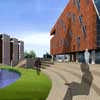
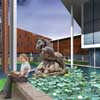
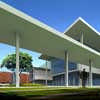
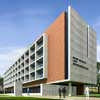
For the city
Although the design of the institute is very modern a conscious effort has been made to fuse into the concept some of the local influences. The curved façade of the library building in the academic block will have sculptures, replicated from Khandagiri caves, in stone embedded into the façade. As one views the academic block, one sees a modern design reinforced with the traditional. The beauty of the sculptures will leave the viewer speechless as one is reminded of the rich culture and history of the state.
The traditional courtyard here is in the form of a central stepped plaza, designed using solid laterite blocks, locally available in Orissa, which leads to a water body. Keeping the climatic factors in mind, the central water court acts as a natural exhaust cooling the air passing over it making the middle court a solace in the hot summer.
Large overhanging roofs, pergolas, colonnades are some of the traditional elements which have been used in the design.
A combination of brick cladding and painted surfaces have been used throughout the campus, giving it a very earthy and sobering feel especially in the summer.
A strong vertical axis is created in the form of a tower as a feature element, with a visibility from 3kms away, making the campus a landmark in the surrounding areas.
This design is a confluence of the traditional with the modern, where we allow the past to catch up with us, remind us where we come from, while taking a leap into the future.
As famous architect Frank O. Gehry said ‘Architecture should speak for its time and place, but yearn for timelessness’, we attempt to do just that.
IMI Campus Bhubaneswar images / information from ADS Designs Pvt. Ltd.
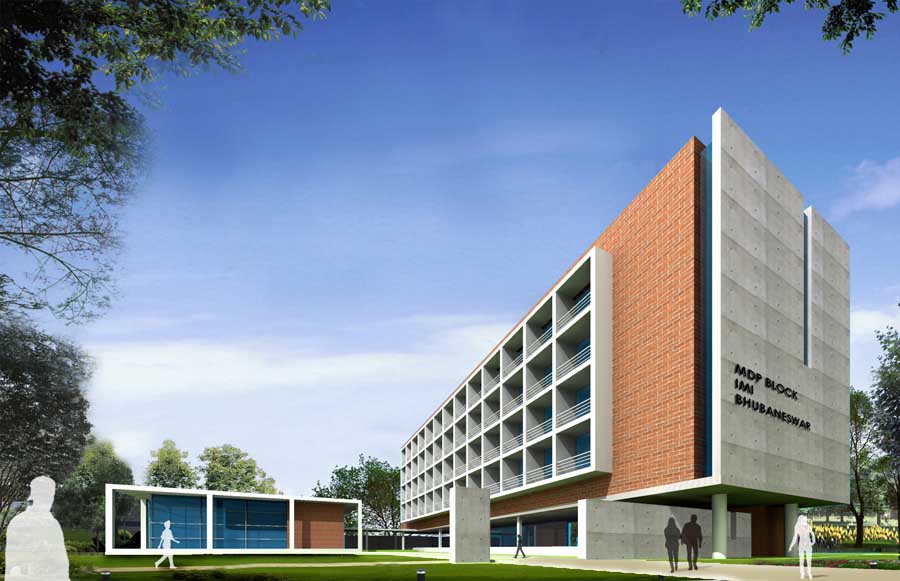
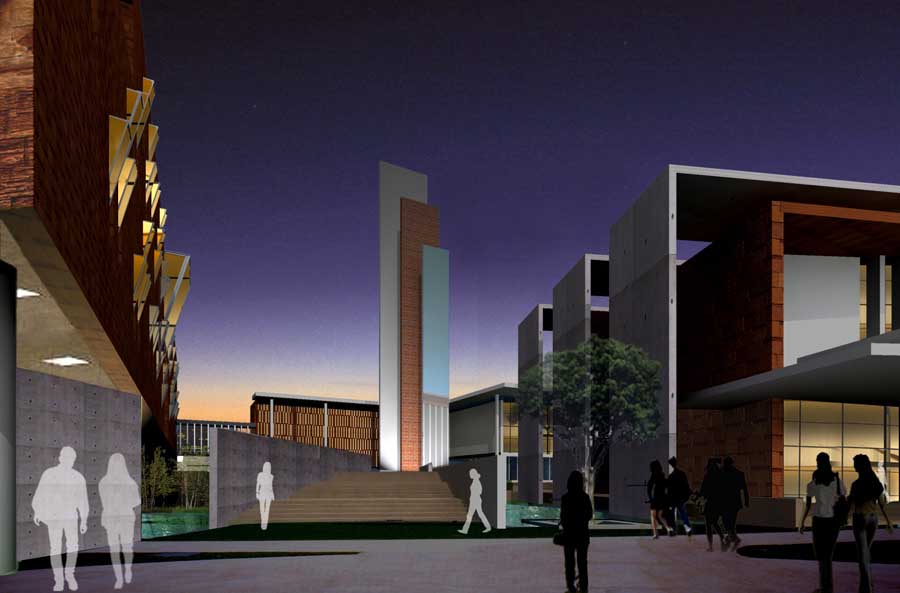
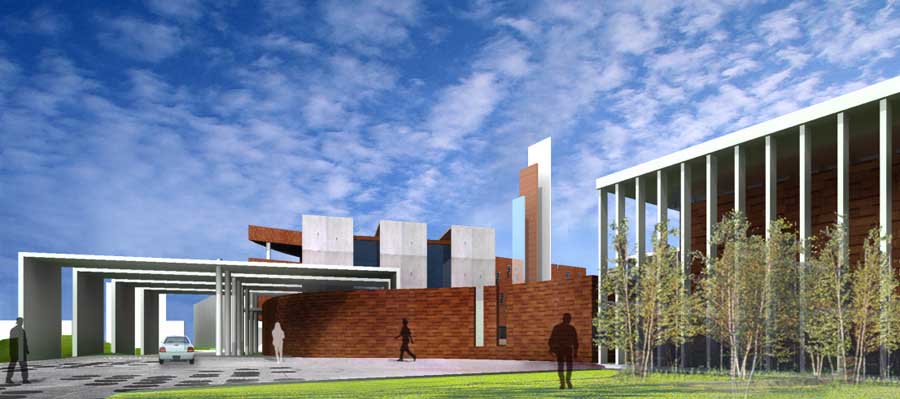
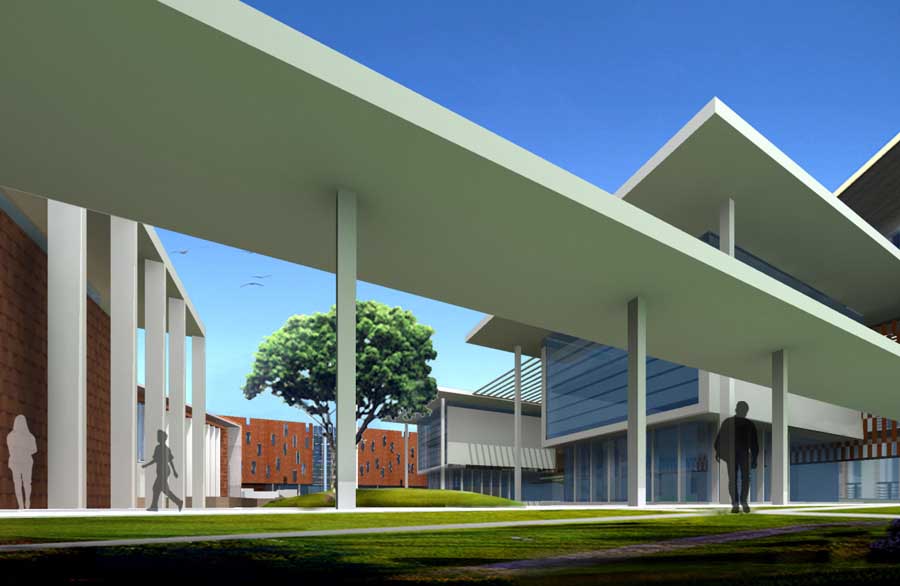
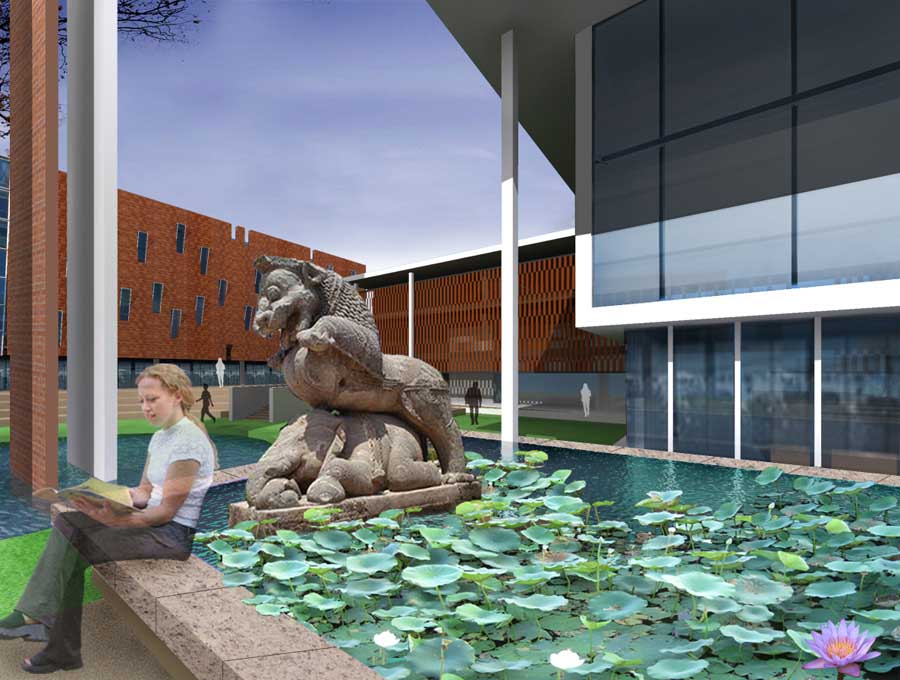
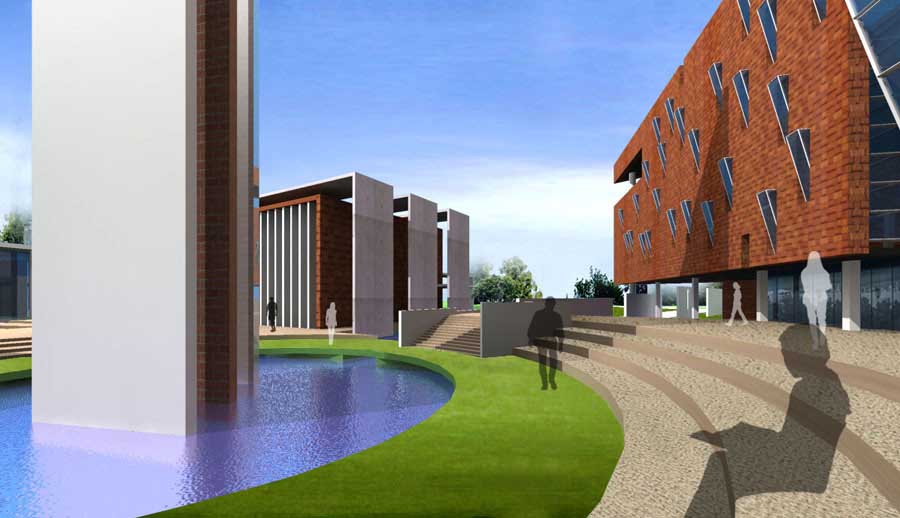
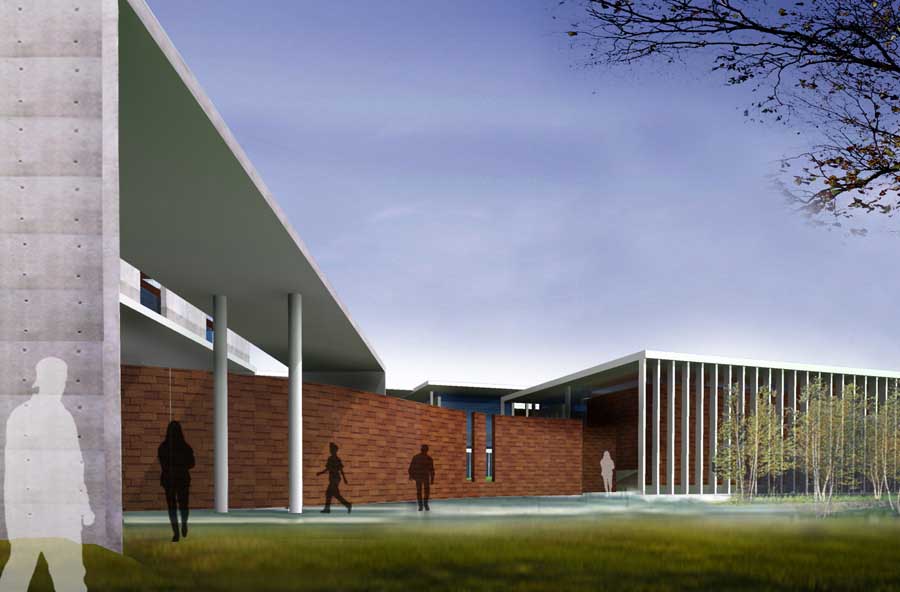
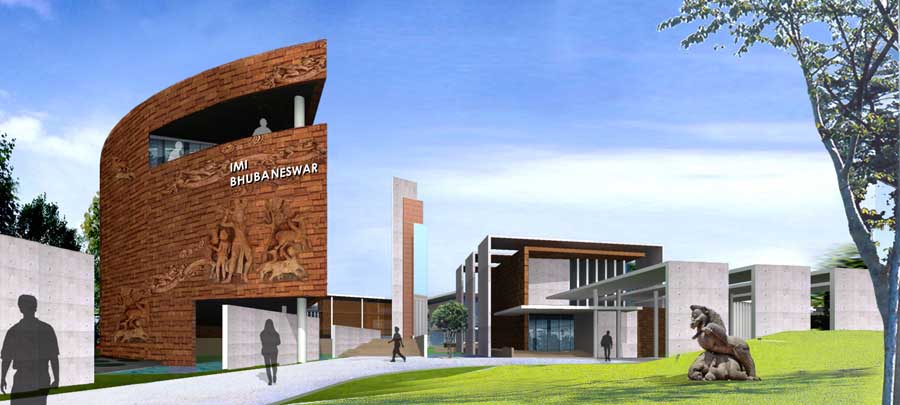
March 15th, 2011
Following is from http://www.e-architect.co.uk/india/nift_campus_bhubaneswar.htm.
‘Fashion is architecture: it is a matter of proportions’ said Coco Chanel, and rightly so. So why not let each be the inspiration for the other!
Orissa, a state widely known for its opulent cultural heritage and rich architecture has a history atypical from that of the northern plains. Unlike other parts of India, tribal customs and traditions have played a significant role in shaping the heritage of the state.
The unique and beautiful appliqué artwork of Pipili; silver filigree ornamental works and patta chitras; and tie and dye and Sambalpuri textiles in all its artistic grandeur awakens the imagination of creative minds.
An institute designed for budding designers and then the maestro, are the inner soul of the complex in very much the same way as the rich culture of Orissa is its inner soul.
The inner soul needs a shell. Shell and soul are interdependent and independent, belonging to each other and to themselves.
Here, the built form developed from climatic factors and conceptualized by elements of the crafts and nature, forms a shell for its soul providing them with spaces to imagine and innovate or simply to inspire.
REALITY
The site is located an uncongested area of Bhubaneswar. The architecture of Bhubaneswar is one of indoor and outdoor spaces merging into each other, the use of which is influenced by climate and season. It is an architecture which has risen from native soil-sacred and pure.
A simple yet modern architecture vocabulary has been adopted. The traditional courtyard here is in the form of a central stepped plaza, interspersed with trees and green patches, which leads to a water body. Keeping all climatic factors in mind, the central lotus water court acts as a natural exhaust, cooling the air passing over it, making the middle court a solace in the hot summer.
Designers dare to dream, to imagine, innovate and create that which is used, seen and felt by all. Someone once said “its not what you look at that matters, its what you see” and feel.
Dieter Rams rightly said:
“Good design is innovative.
Good design makes a product useful.
Good design is aesthetic.
Good design makes a product understandable.
Good design is unobtrusive.
Good design is honest.
Good design is long-lasting.
Good design is thorough down to the last detail.
Good design is environmentally friendly.
Good design is as little design as possible.”
We dream big and beyond the realms of imagination to create the unique. When soul and shell unite the destiny is ‘creation’.
Let us all dare to dream…
National Institute of Fashion Technology Campus Bhubaneswar images / information from Abin Design Studio
March 15th, 2011
With large number of seats falling vacant in the last two years, this is a good decision. Although, they have decided not to approve any new engineering colleges this year, there may be a handful (5-6) that were approved by the Odisha government last year but did not get AICTE approval in time, which may be able to go forward this year. (I am not sure, if they will need a fresh No Objection certificate from the state.)
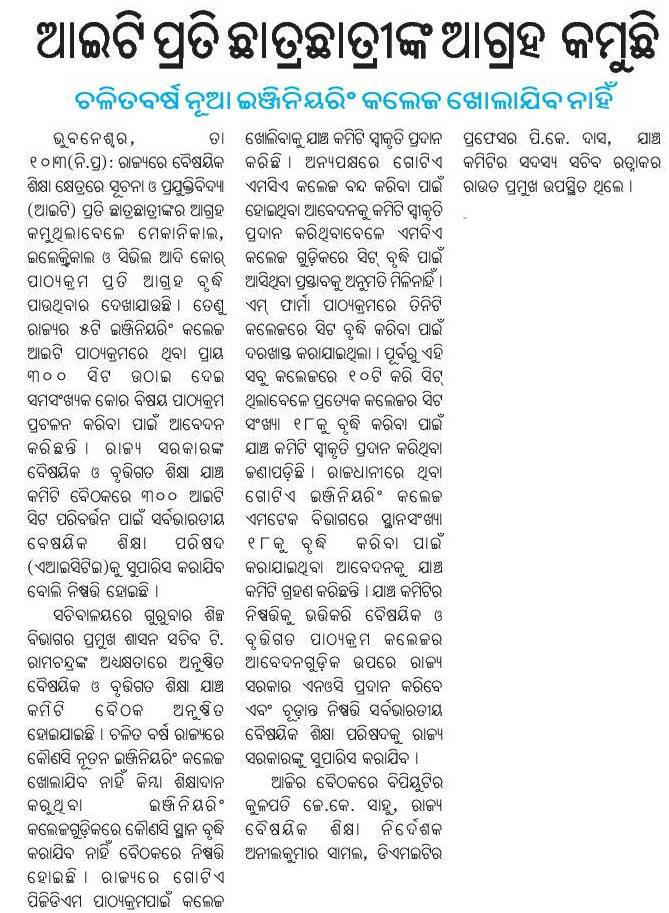
March 11th, 2011
The following is from a PIB dated 9th March 2011.
In order to bring more and more workers under coverage of ESI Scheme in the country, the ESI Corporation has taken the following steps;
The Corporation prepares a phased programme for implementing the scheme in new areas every year in consultation with the State Governments. The position of implementation/extension of ESI Scheme in new areas during the last 3 years is given below:-
|
Year
|
New areas where scheme implemented
|
No. of employees covered
|
|
2007-2008
|
37
|
97,739
|
|
2008-2009
|
46
|
70,427
|
|
2009-2010
|
53
|
1.23 lakh
|
|
2010-2011
|
68*
|
1.14 lakh *
(upto 03-03-2011)
|
The wage ceiling for coverage of employees under the Act has been enhanced from Rs.10,000/- p.m. to Rs.15,000/- p.m. w.e.f. 01-05-2010.
A uniform threshold of 10 or more persons for coverage of factories has been prescribed vide ESI (Amendment) Act, 2010.
State Governments have been requested to lower the threshold for coverage of shops and other establishments from 20 persons to 10 or more persons under the powers conferred upon them under Section.1(5) of the Act. Already the State Governments of Bihar, Punjab, Rajasthan and West Bengal have issued notifications in this regard.
The steps taken by the Corporation to make the scheme more favourable are as follows:
* Improving work environment and facilities for Insured Persons (IPs) visiting ESIC Offices.
* Payment of Long term benefits through Electronic Clearing Scheme (ECS).
* Rates of cash benefits have been enhanced and entitlements have been enlarged.
* Cashless provision of super specialty services through network hospitals.
* Modernisation and up gradation of medical infrastructure.
* Issue of smart cards called ‘Pehchan’ and networking of all ESI institutions for easy access.
To overcome the shortage of doctors in hospitals, filling up of vacant posts is being done on an ongoing basis. To overcome the shortage of doctors, including specialists in the long run and to improve the quality of medical care, the ESI Corporation has started various Medical Education Projects.
The ESI Corporation proposes to set up 18 Medical Colleges in the country in phases. The details are as under.
|
Sl.
No.
|
State
|
Location of Project
|
Project
|
|
| |
|
1
|
Andhra Pradesh
|
Hyderabad
|
Medical College
|
|
|
2
|
Bihar
|
Patna
|
Medical College
|
|
|
3
|
Gujarat
|
Naroda
|
Medical College
|
|
|
4
|
Haryana
|
Faridabad
|
Medical College
|
|
|
5
|
Himachal Pradesh
|
Mandi
|
Medical College
|
|
|
6
|
Karnataka
|
Gulbarga
|
Medical College
|
|
|
Bangalore
|
Medical College
|
|
|
7
|
Kerala
|
Kollam
|
Medical College
|
|
|
8
|
Maharashtra
|
Mulund
|
Medical college
|
|
|
9
|
Madhya Pradesh
|
Indore
|
Medical College
|
|
|
10
|
New Delhi
|
Basaidarapur
|
Medical College
|
|
|
11
|
Orissa
|
Bhubaneswar
|
Medical College
|
|
|
12
|
Rajasthan
|
Alwar
|
Medical College
|
|
|
13
|
Tamil Nadu
|
Chennai
|
Medical College
|
|
|
Coimbatore
|
Medical College
|
|
|
14
|
Uttarakhand
|
Haridwar
|
Medical College
|
|
|
15
|
West Bengal
|
Kolkata
|
Medical College
|
|
|
Baltikuri
|
Medical College
|
|
This information was given by Shri Mallikarjun Kharge, Minister for Labour and Employment in a written reply to a question in the Rajya Sabha today/
YSK: PM
March 9th, 2011
The following is from http://www.centraluniversityorissa.ac.in/Faculty_Details.asp?pgid=4 with the information in blue added via web searching.
| 1. Dr. Kanhu Charan Satapathy (Centre for Anthropological Studies) Ph.D in Anthropology, 2007, Utkal University. Previously faculty at SM Govt. Women’s College, Phulbani. Successfully completed the UGC Refresher Course training program in Anthropology at UGC Academic Staff College, Utkal University, Bhubaneswar, Orissa. Published a book on "Refugees’ Health" by Athena Books, 2010. Presented a research paper entitled ‘Tibetans in India and Their Coping Strategies from a Bio-Cultural Perspective" at the National Seminar on Bio-Cultural Anthropology: Prospects and Challenges, organized by Post-Graduate Department of Anthropology, Utkal University, Bhubaneswar in Collaboration with Anthropological Survey of India, Kolkata from 27-28 March, 2010. |
|

|
| 2. Dr. Meera Swain (Centre for Anthropological Studies) Previously faculty at NISWASS Bhubaneswar. Presented a research paper entitled "Social Responsibility, Awareness and Participation of Local Communities in Conserving the Coastal Environment: A Study in Orissa, East Coast of India" at the National Seminar on Bio-Cultural Anthropology: Prospects and Challenges, organized by Post-Graduate Department of Anthropology, Utkal University, Bhubaneswar in Collaboration with Anthropological Survey of India, Kolkata from 27-28 March, 2010. |
|

|
| 3. Dr. Debendra Biswal (Centre for Anthropological Studies) Ph.D in Anthropology, Delhi University. Thesis title: Ecology and Health : A Comparative Study of Kutia Kondhs and Gonds in Orrisa. Presented a research paper entitled “Ecosystem approach in health: Is it holistic or partial?” at the National Seminar on Bio-Cultural Anthropology: Prospects and Challenges, organized by Post-Graduate Department of Anthropology, Utkal University, Bhubaneswar in Collaboration with Anthropological Survey of India, Kolkatafrom 27-28 March, 2010. |
|

|
| 4. Dr. Kailash Bantha (Centre of Odia Language & Literature) Publication of D Litt.Thesis titled "Fakir Mohanka Katha Sahitya re Karma Fala". Edited "Ratnakar Chaininka Charoti Chhoto Natak and Amurta Manara Murta Bhaskar". Publication of Ph.D thesis titled "Oriya Upanyasre Shaitan Charitra". Felicitation by "Dakhin Orissa Sanskrutik Sansad, Malkangiri". |
|

|
| 5. Dr. Rudrani Mohanty (Centre of Odia Language & Literature) Words fail to express my heartfelt feelings when I boarded Hirakhand Express to join as a faculty in the noscent Central University at the bosom of nature in Koraput. Lush green hills, the beautiful bounties of nature, the offectionate studentant teacher relationship in campus added a lively chapter in my life under the caring and guiding umbrella of our dynamic University authority. It makes my life poetic as well as practical and engrossing. |
|

|
| 6. Dr. Ganesh Prased Sahu (Centre of Odia Language & Literature) The Central University of Orissa, Koraput has created educational revolution in Orissa. Basically the Tribal Students of southern Orissa will be involved in that progress. The University has focused on Humanities Study like School of Languages (Oriya & English) and School of Social Sciences (Anthropology & Sociology). The students are really lucky as the first batch of this University. They are keenly interested to attend class programmes at Koraput and try to prove their potentialities through examinations. Being a lecturer I always trying to inculcate inclinations of subjects with deep root of knowledge to my students. Every part towards development of this University is going on smoothly with a proper guidance and good ideology. I wish all betterment and a prosperous future to this new Central University. |
|

|
| 7. Dr. Kapila Khemundu (Centre for Sociology Studies), Ph.D in 2008-09 from JNU. Thesis: Indian Sociology and its Engagement with Values: A Comparative Study of Select Discourses. It is encouraging that the newly established Journalism and Mass Communication, Anthropology, Sociology, Oriya and English Departments in the Central University of Orissa, Koraput are shaping up under the dynamic leadership of University authority along with newly recruited young energetic faculty. Their commitment towards teaching and learning activities is positive indication to establish a vibrant academic tradition to achieve the aims and objectives of the higher education in the country. I firmly believe despite having its location in remote area this university will be recognized in near future as a centre for excellence in education. |
|

|
| 8. Aditya K. Mishra has joined as a Lecturer in the Centre for Sociological Studies on 8th February, 2010. He has done his M.A., M.Phil & Ph.D (TBA) from the prestigious University of Hyderabad. He has published various research papers and reviews in leading peer-reviewed journals. He has also presented several research papers in national and international conferences. His research interests include Sociology of Development, Sociology of Health, Environmental Sociology and Contemporary Socio Economic issues. He can be reached at adityamishra80@gmail.com
Presented a research paper (co-authored by Prof. E. Haribabu [University of Hyderabad]) entitled ‘Interrogating Participatory Biodiversity Conservation: Social Capital, CBCDCs and Conservation Outcomes’ at the National Seminar on Bio-Cultural Anthropology: Prospects and Challenges, organized by Post-Graduate Department of Anthropology, Utkal University, Bhubaneswar in Collaboration with Anthropological Survey of India, Kolkata from 27-28 March, 2010.
|
|

|
| 9. Sujit Kumar Mohanty has joined as a Lecturer in the Centre for Media Studies on 8th February, 2010. He has done his M.A. (Communication) from the prestigious University of Hyderabad. He is currently pursuing his M. Phil in the Centre for Regional Studies, University of Hyderabad. He was worked with a leading English newspaper of the Southern India – Deccan Chronicle and also undertaken a project with UNICEF. He was also associated with CNN – IBN (New Delhi) for a short while and then moved to TV9 – English as an assignment editor. His research interests include Media and Development, Film Studies & Religion and Politics in Media. He can be reached at sujitadm@gmail.com |
|

|
| 10. Talat Jahan Begum has joined as a Lecturer in the Centre for Media Studies on 8th February, 2010. She has done her M.A in Journalism and Mass Communication from Utkal University. With a teaching experience of 20 years, she has taught Journalism and Mass Communication at the prestigious BJB Autonomous College at Bhubaneswar. She was worked as Project Coordinator for UNICEF sponsored Project on "Children Reporting Children Issues". She has participated in International Visitor Leadership Program on "Community Approaches to Social Issues" in USA in 2008. She has also worked with ETV. She is actively involved with the NSS. Her research interests include Mass Communication Research, Community Media &TV Journalism. She can be reached at talattjb@yahoo.co.in |
|

|
| 11. Sony Parhi (Centre for Journalism and Mass Communication Studies) The Central University of Orissa, Koraput is the outcome of long cherished dreams. Hard work, initiative, collaboration and readiness to face challenges are hallmarks of Journalism and Mass Communication faculty and students. The remoteness of the place and challenges in communicating effectively with a varied audience give ample avenues to our entire team. Rich cultural heritage of this region and the task of disseminating the same through agencies of mass media for holistic progress is our goal. This University also teaches me to pursue knowledge and research while maintaining empathy and harmony towards my environment. |
|

|
| 12. Sanjeet Kumar Das (Centre of English) Having joined in the Department of English, Central University of Orissa, Koraput, I am overwhelmed to disseminate my experiences to young and energetic students in the field of language and literature. The leitmotif of our ‘School of Languages’ is to import education and research in new vistas such as Women writings in the Post modern era, Ecocriticism, literature on Diaspora writings etc. In the domain of linguistics, we focus our research on applied areas such as Computational linguistics, Evolutionary linguistics, Biolinguistics, Cognitive linguistics, Neuro-linguistics, Ethno linguistics, and Geolinguistics etc. Nevertheless, theoretical linguistics like Phonology and phonetics, morphology, syntax, semantics and pragmatics are also emphasized for the development of communicative competence among the students. I am pursuing my Ph. D in the Department of Humanities & Social Sciences, IIT Kanpur. |
|

|
| 13. Himani Mishra (Centre for Sociology Studies) The Central University of Orissa, Koraput is now in the stage of infancy and has a long way to go ahead. Still it is constructing the good architects for our future and one day it will definitely achieve this goal where it will be among the best Universities giving proper shapes to the students. Being a part of this newly built institute, I feel glad. |
|

|
March 8th, 2011
The following is compiled from http://www.iiit-bh.ac.in/faculty/faculty-list and http://www.iiit-bh.ac.in/downloads/AdmissionBrochure2011.pdf?attredirects=0&d=1.
Computer Science:
- Dr. Gopal Krishna Nayak, B. Tech (IIT Kharagpur), PGDM (IIM Bangalore), Ph.D. (IIT Kharagpur), Professor & Director
- Mr. Ajit Kumar Das, B. Tech (IIT Kharagpur), M. Tech (UU), Ph.D. Continuing (UU), Professor & Dean
- Dr. Rakesh Chandra Balabantaray, M. Tech (UU), Ph. D. (UU), Assistant Professor
- Dr. Anjali Mohapatra, M. Tech. (UU), Ph. D. (UU), Assistant Professor
- Ms Puspanjali Mohapatra, M. Tech.(UU), Lecturer
- Mr. Muktikanta Sahu, M. Tech. (BPUT), Lecturer
- Dr. Debasish Jena, BE, M.Tech.(UU),Ph.D.(NIT, Rourkela), Assistant Professor
- Mr. Alok Chakrabarty , Ph.D. thesis submitted (Assam Univerisity), Lecturer
- Dr. Hemanta Kumar Pati , Ph.D. (IIT Kharagpur), Assistant Professor
- Mr. Suvendu Rup ,B.E(UU) , M.Tech.(Jadavpur University), Ph.D. continuing (NIT Rourkela), Lecturer
- Dr. Sudarsan Padhy, Ph.D, Emeritus Professor (Retired from Utkal University)
- Dr. Shakti Ranjan Mohapatra, Ph.D, Visiting Faculty, from CITE Bhubaneswar
- Dr. Ajit Nayak, Ph.D, Visiting Faculty, from ITER, SOA University Bhubaneswar
Electrical Engineering:
- Ms. Usharani Rout, M. Tech.(BIT, Mesra), Lecturer
- Mr. Tapas Kumar Panigrahi , M. Tech.(Bengal Engineering College), Senior Lecturer
- Ms. Umamani Subudhi , M.Tech.(UCE, Burla), Lecturer
Electronics:
- Mr. Harish Kumar Sahoo ,M.Tech.(NIT,Rourkela),Ph.D. continuing (Sambalpur University), Senior Lecturer
- Mr. Ratnakar Dash , M. Tech.(UCE, Burla), Ph.D.continuing (NIT, Rourkela), Lecturer
- Mr. Tapas Patra, Visiting Faculty, From CET Bhubaneswar
Mechanical Engineering:
- Mr. Bamadev Sahoo, M. Tech. (IIT Kharagpur), Senior Lecturer
- Mr. Biranchi Narayan Padhi , M. Tech.(UCE, Burla), Ph.D. continuing (NIT Rourkela), Senior Lecturer
- Dr. L. N. Panda, Ph.D, Visiting Faculty, From CET Bhubaneswar
- Dr. P. K. Satapathy, Ph.D, Visiting Faculty, From CET Bhubaneswar
Physics:
- Dr. Monalisa Ray, M.Phil., Ph.D.(UU), Senior Lecturer
- Dr. Biswajit Pradhan, Ph.D.(IIT Bombay), Lecturer
- Mr. R. K. Parida, Visiting Faculty, From ITER, SOA University
Chemistry:
- Dr. Satyanarayan Pal, Ph.D.(CU, Hyderabad), Senior Lecturer
- Dr. Hiranmayee Satapathy, Ph.D.(IIT Kharagpur), Lecturer
Mathematics:
- Dr. Rupaj Kumar Nayak, Ph.D.(UU), Assistant Professor
- Dr. Manas Ranjan Tripathy , Ph.D .(IIT Kharagpur), Lecturer
Humanities:
- Ms. Lipika Das, Lecturer, M. A., M.Phil., Ph.D.continuing (UU) – Communicative English, Lecturer
- Dr. Tanutrushna Panigrahi, Ph. D. (Berhampur University) – Communicative English, Senior Lecturer
March 5th, 2011
(Thanks to Kalahandia for the pointer.)
Following is from http://expressbuzz.com/states/orissa/medical-college-to-see-light-of-the-day/253254.html.
The last one year has rekindled hopes for Kalahandi waiting since long for a medical college as promised by the State Government. Sardar Raja Medical College at Jaring is expected to start functioning from 2012 academic year, the chief executive officer of the college Tarun Mishra announced at a press meet here.
The project got clearance from the State Government in 2004 after an MoU was signed with a private educational institute Salvam Educational and Charitable Trust, Tamil Nadu. The Revenue Department provided 25 acres at Jaring and Western Orissa Development Council released Rs10 crore for infrastructure development. Work soon picked up on the 300-bed hospital, college and hostel buildings.
However, the project suffered a setback with the chairman of the trust entangled in a legal battle in Tamil Nadu. The long court battle had raised doubts about the future of the project. Last year, the college also failed to get a nod from the Medical Council of India mostly due to lack of adequate number of doctors, staff and some basic infrastructure. This had led to resentment among the locals.
With the charges against the chairman of the trust dropped, the project witnessed some positive development this year.
Mishra said that the infrastructure as pointed out by MCI has been put in place. The Health and Family Welfare Department has already issued essentiality certificate and Sambalpur University given consent for affiliation. MCI permission has already been sought and the team is expected to be here soon. Pending works have been taken up on a war-footing to meet the MCI stipulations, he added.
The chairman of the Salvam Educational and Charitable Trust SA Raja, in a press release, said that the commitment for establishment of a medical college and super speciality hospital will be fulfilled and he thanked people for their cooperation for success of the project despite undue delay.
It would be interesting to see whether this one becomes operational first or the AIIMS-like institute in Bhubaneswar gets operational first. Looks like both are scheduled to take in students in 2012. The foundation stone of the AIIMS-like institution was laid in 2003, a year earlier than the medical college in Kalahandi.
March 4th, 2011
Previous Posts
